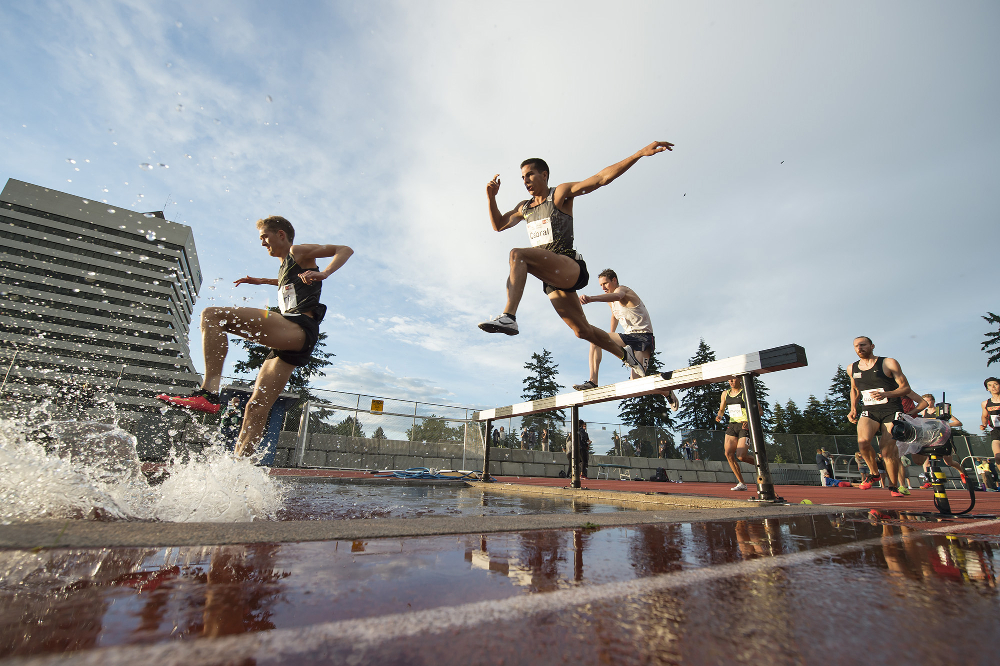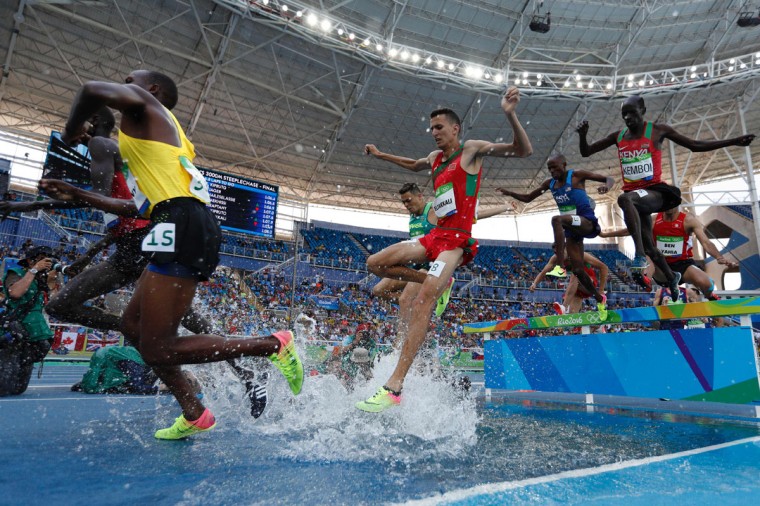History and Evolution of Steeplechase in the Olympics: Steeplechase Olympics Fall

The steeplechase, a grueling endurance race that combines running with obstacle jumping, has been a staple of the Olympic Games since 1900. Its journey through the Games reflects the evolution of athleticism and the ever-changing landscape of sports.
Origins and Early Evolution
The steeplechase emerged in the mid-19th century, inspired by cross-country races in England. These early races often involved leaping over natural obstacles like ditches and fences, mirroring the challenges faced by fox hunters. The first recorded steeplechase took place in 1830 at the Sandown Park Racecourse in Surrey, England. The term “steeplechase” originates from the fact that the early races often included a landmark church steeple as a reference point.
The early steeplechase events in the Olympics differed significantly from the modern version. The 1900 Paris Games saw a 2,500-meter race with a single hurdle and a water jump. This initial iteration was more akin to a cross-country race with a few obstacles.
Formalization and Standardization
As the sport evolved, the steeplechase became more formalized. The International Amateur Athletic Federation (IAAF), now known as World Athletics, introduced standardized rules and regulations for the event. The 1920 Antwerp Games saw the introduction of the current distance of 3,000 meters, with 28 obstacles and seven water jumps.
This standardization ensured a more consistent and challenging race for athletes. The water jumps, in particular, added a unique element of difficulty, requiring athletes to navigate a water obstacle with a significant impact on their overall pace.
Key Moments and Athletes
The steeplechase has seen some of the most iconic moments in Olympic history.
- 1932 Los Angeles Games: The American athlete, Glenn Cunningham, set a new Olympic record of 9:06.8, a mark that stood for over two decades. Cunningham’s performance showcased the endurance and technical skill required for the steeplechase.
- 1964 Tokyo Games: The Kenyan runner, Amos Biwott, won the gold medal with a time of 8:30.8, demonstrating the growing dominance of Kenyan athletes in the event.
- 1980 Moscow Games: The Polish athlete, Bronisław Malinowski, set a new world record of 8:09.74, solidifying his place as one of the greatest steeplechasers of all time.
- 2008 Beijing Games: The Kenyan runner, Brimin Kipruto, set a new Olympic record of 8:01.18, showcasing the exceptional athleticism and strategic running that characterizes the steeplechase.
Technical Aspects of Steeplechase

The steeplechase, a unique track and field event, combines the endurance of long-distance running with the technical challenges of hurdling and water jumps. This blend of athleticism and skill requires a specific set of techniques and strategies to excel.
Water Jumps
Water jumps are a defining characteristic of the steeplechase, adding a unique dimension to the race. Mastering the technique of clearing the water jump is crucial for success.
- Approach: Athletes typically approach the water jump at a slightly faster pace than they would a hurdle, maintaining momentum. The ideal approach angle is between 45 and 60 degrees, allowing for a smooth and powerful takeoff.
- Takeoff: The takeoff should be explosive and powerful, using the athlete’s momentum to launch them over the water barrier. The athlete’s lead leg drives them upward, while the trailing leg provides additional propulsion.
- Landing: The landing is crucial for maintaining speed and momentum. Athletes aim to land on their feet, with their knees slightly bent to absorb the impact. This technique helps minimize the risk of injury and ensures a smooth transition back into running.
Hurdle Technique
The hurdles in a steeplechase are higher than those in other track and field events, demanding a more dynamic and powerful hurdle technique.
- Lead Leg Drive: The lead leg drives forward and up, clearing the hurdle with a strong, quick motion. The athlete’s core remains engaged to maintain balance and stability.
- Trail Leg Clearance: The trail leg follows the lead leg, clearing the hurdle with a swift, upward motion. The athlete’s hips and knees are flexed to ensure the leg doesn’t hit the hurdle.
- Landing: The athlete lands on the ground with their lead leg, maintaining momentum and transitioning smoothly back into running.
Running Styles and Pacing
The choice of running style and pacing strategy significantly influences performance in a steeplechase.
- Running Style: Athletes may adopt different running styles, including a more upright posture or a lower center of gravity. The choice depends on individual strengths and preferences. A lower center of gravity can provide better stability during hurdle clearance and water jumps.
- Pacing: Pacing strategy is crucial for managing energy levels throughout the race. Athletes may opt for a more consistent pace or a more tactical approach, adjusting their pace based on the competition. For example, some athletes may choose to run a faster pace in the early stages of the race to establish a lead, while others may prefer to conserve energy and make a strong push in the later stages.
Course Layout
The steeplechase course is designed to test the athletes’ endurance, agility, and technical skills. The course typically includes:
| Element | Description |
|---|---|
| Starting Line | The race begins on a standard track starting line. |
| Hurdles | 35 hurdles are evenly spaced along the track, with each hurdle being 36 inches high. |
| Water Jumps | Four water jumps are integrated into the course, requiring athletes to clear a water-filled pit. |
| Finish Line | The race ends on the standard track finish line. |
Notable Steeplechase Athletes and Performances

The steeplechase, with its unique combination of speed, endurance, and technical skill, has produced a long line of legendary athletes who have left an indelible mark on the Olympic Games. These remarkable individuals have not only pushed the boundaries of human performance but also inspired generations of runners. This section delves into the stories of these iconic steeplechasers, highlighting their most memorable races and analyzing the impact of technological advancements and training methods on their achievements.
Memorable Steeplechase Races in Olympic History, Steeplechase olympics fall
The Olympic steeplechase has witnessed some of the most thrilling and dramatic races in track and field history. Here are some of the most memorable contests that have captivated audiences worldwide:
- 1980 Moscow Olympics – The “Miracle of Moscow”: This race saw the legendary Czesław Fiedorowicz of Poland overtake the then-world record holder Henry Rono in the final lap, setting a new Olympic record and securing a dramatic victory. This race is remembered for its unexpected outcome and the incredible comeback by Fiedorowicz.
- 1992 Barcelona Olympics – The “Double Gold”: Moses Kiptanui, the Kenyan runner who had already broken the world record twice, dominated the race from start to finish, winning gold with a new Olympic record. He also became the first athlete to win both the 3000m steeplechase and the 1500m in the same Olympics. This achievement cemented his status as one of the greatest steeplechasers of all time.
- 2008 Beijing Olympics – The “Thrilling Finish”: The final lap of the race was a nail-biter, with Brimin Kipruto of Kenya holding off a strong challenge from Ezekiel Kemboi, also of Kenya. Kipruto ultimately won gold in a photo finish, marking a memorable conclusion to a fiercely contested race. This race demonstrated the intense competition and the razor-thin margins that often separate victory from defeat in the steeplechase.
Impact of Technological Advancements and Training Methods
Technological advancements and innovative training methods have significantly impacted steeplechase performances over the years. The development of lighter and more durable shoes, for instance, has allowed athletes to run faster and with greater comfort. Advancements in sports science, such as biomechanics analysis and altitude training, have also contributed to improved performance.
“The use of altitude training has been particularly impactful, as it allows athletes to adapt to thinner air conditions, improving their aerobic capacity and red blood cell count.”
Furthermore, the introduction of specialized steeplechase training programs, which focus on developing the specific skills required for the event, has enabled athletes to optimize their performance. These programs incorporate drills designed to enhance speed, endurance, and the ability to clear the water jump efficiently.
Top 10 Steeplechase Performances in Olympic History
The following table ranks the top 10 steeplechase performances in Olympic history, showcasing the incredible feats achieved by these legendary athletes:
| Rank | Athlete | Nationality | Time | Year | Olympics |
|---|---|---|---|---|---|
| 1 | Saif Saaeed Shaheen | Qatar | 7:55.28 | 2004 | Athens |
| 2 | Ezekiel Kemboi | Kenya | 7:57.18 | 2012 | London |
| 3 | Conseslus Kipruto | Kenya | 7:58.42 | 2016 | Rio de Janeiro |
| 4 | Brimin Kipruto | Kenya | 8:01.16 | 2008 | Beijing |
| 5 | Moses Kiptanui | Kenya | 8:01.77 | 1992 | Barcelona |
| 6 | Julius Kariuki | Kenya | 8:03.04 | 2000 | Sydney |
| 7 | Czesław Fiedorowicz | Poland | 8:05.20 | 1980 | Moscow |
| 8 | Abraham Chepkirwok | Uganda | 8:05.35 | 2004 | Athens |
| 9 | Stephen Cherono | Kenya | 8:06.81 | 2016 | Rio de Janeiro |
| 10 | Paul Kipsiele Koech | Kenya | 8:06.84 | 2008 | Beijing |
Steeplechase olympics fall – The steeplechase, a grueling Olympic event, demands both physical prowess and mental resilience. Athletes must navigate a course punctuated by challenging hurdles and water jumps, testing their balance and agility. After a particularly demanding race, a competitor might find solace in the comfort of a navy blue leather recliner chair , where they can unwind and allow their muscles to recover.
The steeplechase, with its inherent risk of falls, emphasizes the importance of both physical preparation and mental fortitude in achieving success.
The steeplechase event in the Olympics is a thrilling spectacle of athleticism and endurance, with runners navigating challenging obstacles and demanding terrain. The fall of a competitor during this event can be a dramatic moment, highlighting the physical and mental fortitude required to succeed.
Just as the steeplechase demands resilience, a vintage green leather chair embodies a timeless elegance and enduring quality, a testament to craftsmanship and design. The steeplechase, with its unpredictable nature, requires adaptability and determination, much like the vintage green leather chair, which can seamlessly blend into various settings while maintaining its classic appeal.